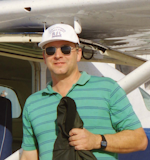In 1994 I decided to build a house. With participation in only one fence-building project before that, I had the good sense to find an old, very experienced carpenter to head up the project with me as his pupil in a schooling that’s served me well for years since. Among the mountain of wisdom he passed to me during that six-month ordeal was the wood-cutting admonition to “measure twice, cut once.”
A recent incident brings to light the critical nature of checking your work twice before you let a pilot have the airplane. It involved a simple generator change on a twin-engine business jet. As with many older aircraft, this one had four wires going to two posts and all of the wires had whatever labels that’d once been on them worn off. The mechanic had done the job many times and apparently decided he could somehow set the wiring aside in some fashion that made sense to him; when the generator was re-installed and the engine cranked a bunch of fuses blew and electrons went into many spaces they shouldn’t go. It took another day and a lot of money to get it all right again.
Two major errors occurred here.
Basic Mechanic 101
First, when you’re getting ready to tear something apart, take a look at the potential problems you’ll have getting it back together. Are certain nuts/bolts used in certain spots? Are there wires going to-and-fro that may not be readily identified when putting it back together? This is Basic Mechanic 101 yet we still manage to mess it up. Is it too much trouble to mark and/or bag things properly? Keep a marker, some tape, or whatever you need in the toolbox to make it easier.
But the more important error here was no one else looked at it. During the followup to the fried fuses, another mechanic looked up at the generator and instantly identified the problem; he, of course, found the wires were backwards when he saw it from a different angle. If he’d looked at it before there would have been no issue when the pilot started the plane.
For 20 years, I worked in a jet engine test facility on F-16 engines. When the P&W F-100 engine first arrived, we were briefed in Air Force familiarization class there was a reason the ’16 was known as the “Lawn Dart.” The earliest version of the engine, the F100-200, had a terrible reliability rate with an in-flight failure every 4,000 hours; they’d get it restarted half the time. At the Hush House test facility, we committed ourselves to doing all we could to prevent engine problems; this paid off when we shared with our engine maintenance people the award from Pratt for flying the F100-200 engine longer without an engine failure than any operator — a forever-to-be-unmatched 55,000 flight hours without a shutdown. At conversion to the much-more-reliable F100-220 engine, we’d done what was widely considered impossible. How?
Double check
Among the various habits we developed was the simple process of asking your co-worker to look at what you’d just done. “Hey, Miles, you wanna’ take a look at that to make sure I did it right?” Every task, every time.
Sometimes I’d have to walk outside to find one of them. And they’d find problems. I’d find problems. Very small ones, like safety wire in the wrong direction, but each one important.
It wasn’t a reflection on the other guy’s abilities, but instead understanding individuals are fallible. They have fights with girlfriends, they get late on payments, their children get hurt on swing sets, they get dust in their eyes.
It is, in fact, a sure sign of a mature mechanic when he/she realizes the lives entrusted to him/her are far more important than their pride. If you know a mechanic that can’t stand to be double-checked, then you’re working with an immature individual that needs to be watched because their pride is getting in the way of good maintenance practices. 55,000 hours without a failure … good practices pay off.
So we now come back to the wisdom of that old carpenter who showed me how to frame a house. If you have someone double check your work, you improve the reliability of your repair. Period. Measure twice, cut once.
Clint Lowe holds an FAA Airframe and Powerplant certificate with Inspection Authorization and a Commercial Pilot certificate with instrument and multi engine ratings. Clint has spent most of his aviation career with the United States Air Force and Air National Guard in a variety of roles including maintenance, safety, training, oversight, and accident investigation. He has owned and maintained several aircraft and had a Part 135 air freight business for several years running bank checks. In 2007 he received the Maintenance Group Senior NCO of the Year Award. He currently is a Quality Assurance Inspector/Quality Assurance Representative with the North Dakota Air National Guard in Fargo, ND.



